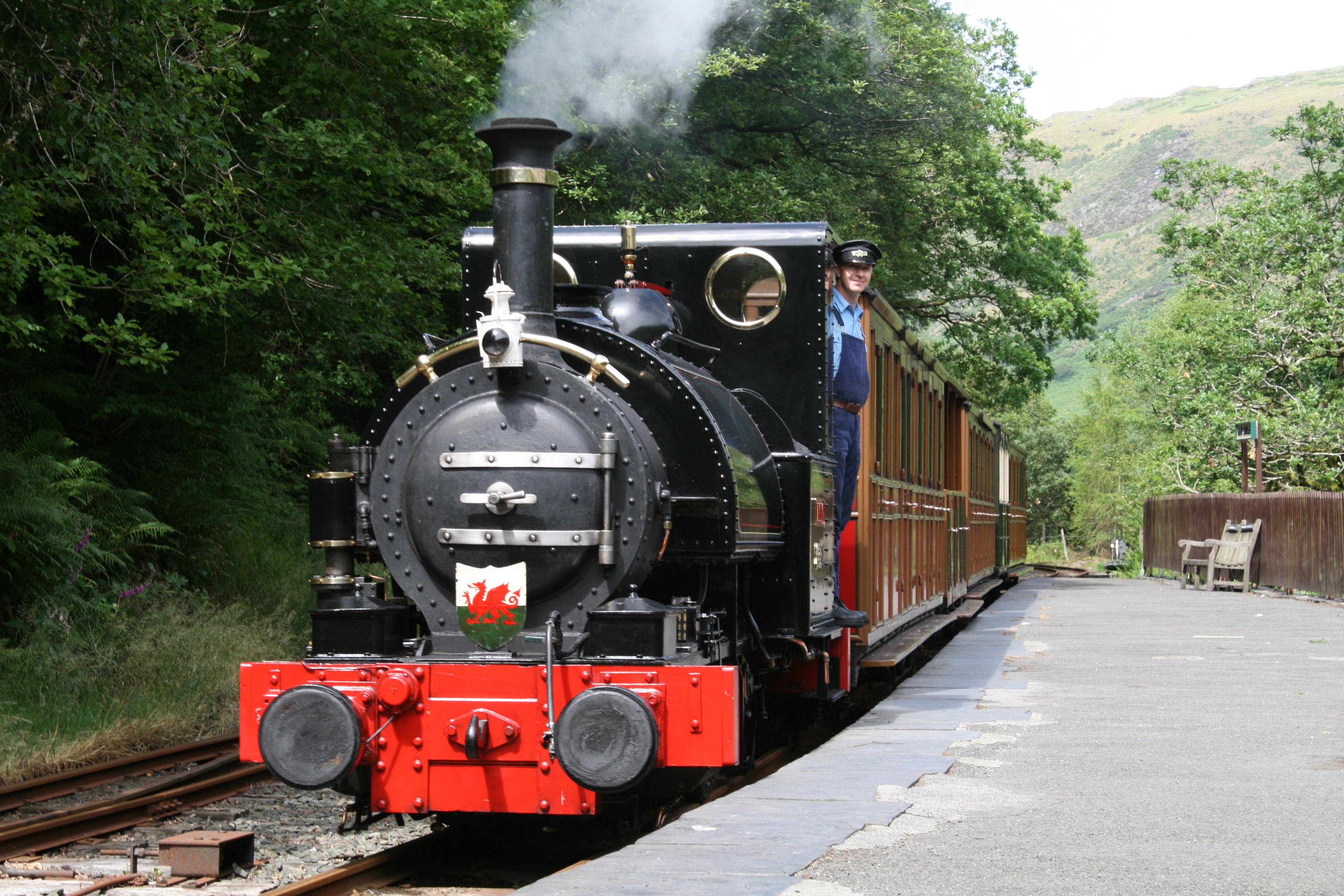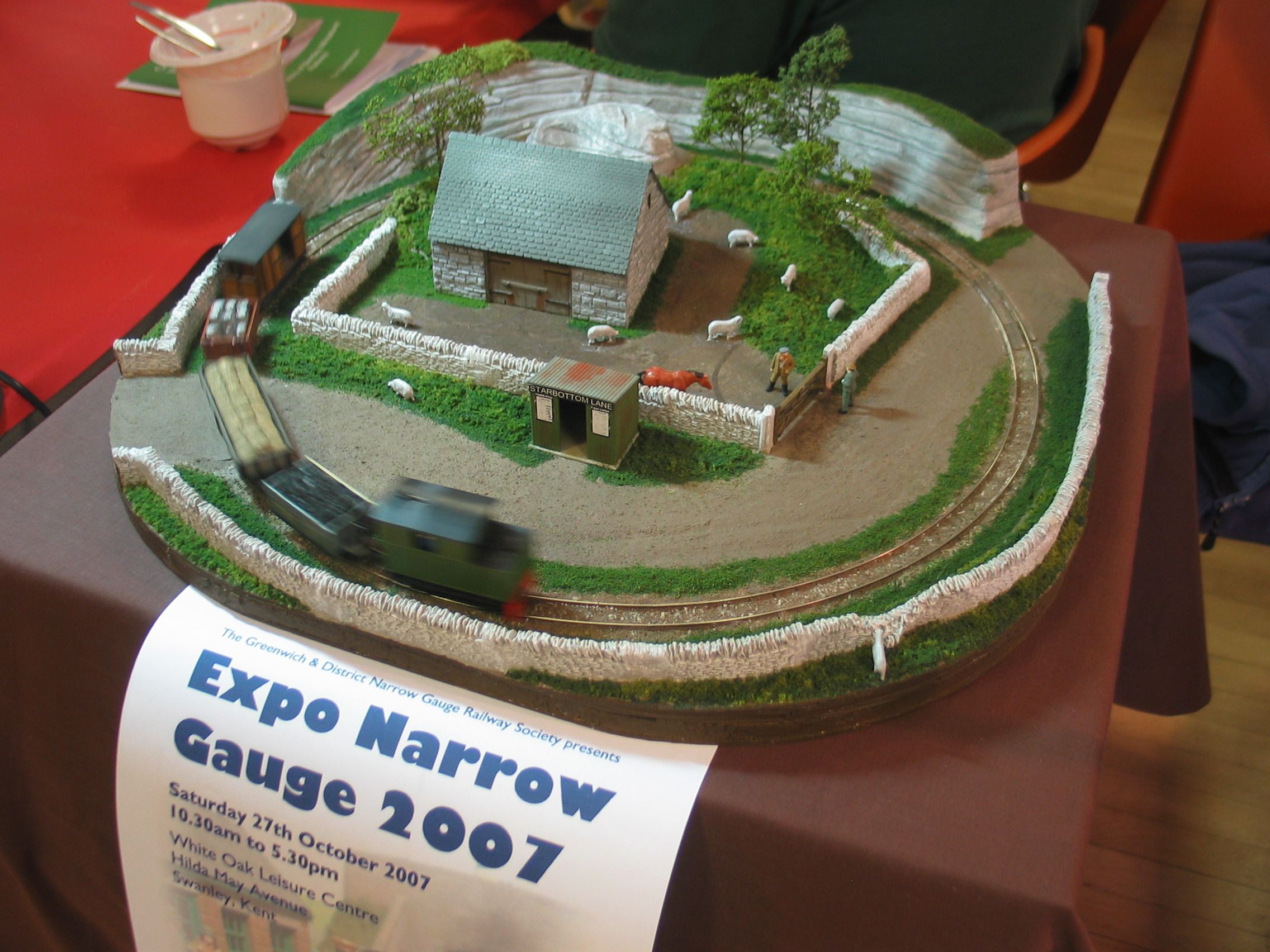|
5.5 Mm Scale
5.5 mm to 1 foot scale (1:55.4 or 1:55) is used for modelling narrow gauge railways. gauge track is used to represent to gauge prototypes. gauge track is used to represent gauge prototypes. Very narrow industrial or rural lines can be represented by N-gauge (9 mm gauge) on OO9-track do give . These 5.5mm could be called "5.5-ind". History 5.5mm scale narrow gauge model railways were developed by GEM in 1963, using gauge track, which was the smallest commercially available gauge at the time (TT gauge). GEM produced kits for locomotives and rolling stock from the Ffestiniog and Talyllyn railways. Following the development of N gauge, using gauge track, the popularity of 5.5 mm scale declined as modellers adopted OO9 which could combine N gauge track and mechanisms with the widely supported 4 mm scale. However 5.5mm scale remained in use and, following an article on the Gwynant Valley Railway by Malcolm Savage in Railway Modeller, October 1984, th5.5mm Asso ... [...More Info...] [...Related Items...] OR: [Wikipedia] [Google] [Baidu] |
Rail Transport Modeling
Railway modelling (UK, Australia, New Zealand, and Ireland) or model railroading (US and Canada) is a hobby in which rail transport systems are modelled at a reduced scale. The scale models include locomotives, rolling stock, streetcars, tracks, signalling, cranes, and landscapes including: countryside, roads, bridges, buildings, vehicles, harbors, urban landscape, model figures, lights, and features such as rivers, hills, tunnels, and canyons. The earliest model railways were the ' carpet railways' in the 1840s. The first documented model railway was the Railway of the Prince Imperial (French: Chemin de fer du Prince Impérial) built in 1859 by Emperor Napoleon III for his then 3-year-old son, also Napoleon, in the grounds of the Château de Saint-Cloud in Paris. It was powered by clockwork and ran in a figure-of-eight. Electric trains appeared around the start of the 20th century, but these were crude likenesses. Model trains today are more realistic, in addition to ... [...More Info...] [...Related Items...] OR: [Wikipedia] [Google] [Baidu] |
Narrow Gauge Railways
A narrow-gauge railway (narrow-gauge railroad in the US) is a railway with a track gauge (distance between the rails) narrower than . Most narrow-gauge railways are between and . Since narrow-gauge railways are usually built with tighter curves, smaller structure gauges, and lighter rails; they can be less costly to build, equip, and operate than standard- or broad-gauge railways (particularly in mountainous or difficult terrain). Lower-cost narrow-gauge railways are often used in mountainous terrain, where engineering savings can be substantial. Lower-cost narrow-gauge railways are often built to serve industries as well as sparsely populated communities where the traffic potential would not justify the cost of a standard- or broad-gauge line. Narrow-gauge railways have specialised use in mines and other environments where a small structure gauge necessitates a small loading gauge. In some countries, narrow gauge is the standard: Japan, Indonesia, Taiwan, New Zealand, S ... [...More Info...] [...Related Items...] OR: [Wikipedia] [Google] [Baidu] |
TT Gauge
TT scale (from "table top") is a model railroading scale at 1:120 scale with a track gauge of 12mm between the rails. It is placed between HO scale (1:87) and N scale (1:160). Its original purpose, as the name suggests, was to make a train set small enough to assemble and operate on a tabletop. The scale originated in the USA, but is today widespread mainly in Central Europe, thanks to Rokal and "'' Berliner-TT-Bahnen''", defunct East German manufacturers of train sets in TT. It is the second-most popular scale in Central Europe and Russia, after HO, with several manufacturers based in countries such as Germany and the Czech Republic, and was reintroduced to the United Kingdom in 2022. Adherents to the scale maintain it is the smallest practical scale, especially for those who like to build models from scratch. In wargaming, TT scale equals the 15 mm scale where the height of "standard" soldier height is . For British 3mm TT scale, see 3 mm scale. History TT scale wa ... [...More Info...] [...Related Items...] OR: [Wikipedia] [Google] [Baidu] |
Ffestiniog Railway
The Ffestiniog Railway () is a heritage railway based on Narrow-gauge railway, narrow-gauge, located in Gwynedd, Wales. It is a major tourist attraction located mainly within the Snowdonia#Snowdonia National Park, Snowdonia National Park. The railway is roughly long and runs from the harbour at Porthmadog to the Slate industry in Wales, slate mining town of Blaenau Ffestiniog, travelling through forested and mountainous terrain. The line is single track throughout with four intermediate passing places. The first mile of the line out of Porthmadog runs atop an embankment called ''the Cob'', which is the Levee, dyke of the polder known as Traeth Mawr. The Festiniog Railway Company, which owns the railway, is the oldest surviving railway company in the world. It also owns the Welsh Highland Railway, which was re-opened fully in 2011. The two railways share the same track gauge and meet at Porthmadog station, with occasional trains working the entire route from Blaenau Ffestinio ... [...More Info...] [...Related Items...] OR: [Wikipedia] [Google] [Baidu] |
Talyllyn Railway
The Talyllyn Railway () is a narrow-gauge railway in Wales running for from Tywyn on the Mid-Wales coast to Nant Gwernol railway station, Nant Gwernol near the village of Abergynolwyn. The line was opened in 1865Drummond 2015, page 17 to carry slate from the quarries at Bryn Eglwys to Tywyn, and was the first narrow gauge railway in Britain authorised by Act of parliament#United Kingdom, Act of Parliament to carry passengers using steam haulage. Despite severe underinvestment, the line remained open, and in 1951 it became the first railway in the world to be preserved as a heritage railway by volunteers. Since preservation, the railway has operated as a tourist attraction, expanding its rolling stock through acquisition and an engineering programme to build new locomotives and carriages. In 1976, an extension was opened along the former mineral line from Abergynolwyn to the new station at Nant Gwernol. In 2005 a major rebuilding and extension of Tywyn Wharf railway station, Ty ... [...More Info...] [...Related Items...] OR: [Wikipedia] [Google] [Baidu] |
N Scale
N scale is a popular model railway scale. Depending upon the manufacturer (or country), the scale ranges from 1:148 to 1:160. Effectively the scale is 1:159, 9 mm to , which is the width of standard gauge railway. However the scale may vary to simulate wide or narrow-gauge rail. In all cases, the ''gauge'' (the distance between the rails) is . The term N ''gauge'' refers to the track dimensions, but in the United Kingdom in particular British N gauge refers to a 1:148 scale with 1:160 () track gauge modelling. The terms N scale and N gauge are often inaccurately used interchangeably, as scale is defined as ratio or proportion of the model, and gauge only as a distance between rails. The scale 1:148 defines the rail-to-rail gauge equal to 9 mm exactly (at the cost of scale exactness), so when calculating the rail or track use 1:160 and for engines and car wheel base use 1:148. All rails are spaced 9 mm apart but the height can differ. Rail height (in thousandt ... [...More Info...] [...Related Items...] OR: [Wikipedia] [Google] [Baidu] |
Worsley Works
Worsley Works, is a manufacturer of kits for model railway carriages and locomotives, owned and run from Worsley, near Manchester, England UK, by Allen Doherty. Worsley Works is well known in the finescale modelling world, especially in less-popular scales, including British HO scale and 3mm-scale models along with various kits for Narrow Gauge railways, particularly OO9 and OOn3. Assembly of Worsley Works kits, like for most other kits that comprise only etched components, is challenging. Worsley specialises in what are described as 'scratch aid' kits, indicating that the kits are not intended to build complete models in themselves, but rather to provide the essential components to assist the process of scratch building. By manufacturing only the etched brass or nickel silver Nickel silver, maillechort, German silver, argentan, new silver, nickel brass, albata, or alpacca is a cupronickel (copper with nickel) alloy with the addition of zinc. The usual formulation is 60 ... [...More Info...] [...Related Items...] OR: [Wikipedia] [Google] [Baidu] |
List Of Narrow-gauge Model Railway Scales
__FORCETOC__ Railway modelling has long used a variety of scales and gauges to represent its models of real subjects. In most cases, gauge and scale are chosen together, so as to represent Stephenson standard gauge. By choosing a smaller gauge than this for a particular scale, the model represents a narrow-gauge example. Such gauge and scale combinations are of course used for the deliberate modelling of particular narrow-gauge subjects, where the choice of subject is behind the choice of combination. Narrow-gauge modelling has also become especially popular from the purely modelling aspects: it combines a conveniently visible large scale that is easier to work on, with a narrow model gauge that allows tighter radius curves and so fits layouts into smaller spaces. This has been a particular reason in Europe where, houses being generally smaller than in the US, there is rarely space for 0 gauge and even 00 gauge is restricted in the size of curves. At times, particularly in the ... [...More Info...] [...Related Items...] OR: [Wikipedia] [Google] [Baidu] |





